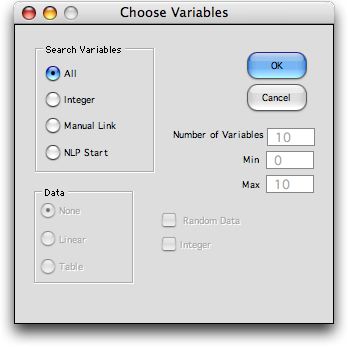| |
We improve combinatorial solutions by changing
one or more variable values in the solution and observe whether
the change results in an improvement. With an organized search
over some neighborhood of adjacent solutions an initial solution
may often be improved. The improvement methods are heuristics
in that they do not necessarily find the optimum, but they require
many fewer observations than exhaustive enumeration. While exhaustive
enumeration methods require exponentially increasing effort
to solve problems of increasing size, improvement methods for
specified parameters usually require polynomially increasing
effort.
We use the integer-nonlinear math programming model shown below.
The model shows the solution found with the Excel Solver. Since
the continuous version of the objective function is concave,
this should be the optimum solution. |
|
| |
To solve the problem with combinatorial search we choose the
Math Program option from the Optimize menu. Select All in
the dialog presented.

The only apparent change is the combinatorial form
starting in cell U1. Not so obviously, the variables are renamed
so the combinatorial search procedures will manipulate the
variables in the search for the optimum. The search procedures
use the Lower and Upper bounds to limit the range of the search.
Although the form shows the Exhaustive search method,
that may be changed with the Search command.

|
Greedy Solution |
| |
To illustrate the improvement options,
we first set all the variables to zero and use the greedy method
to find a feasible solution. The best solution, found after 78
runs, has the objective value of 122.45. Other feasible solutions
are shown in the list below and the greedy solution is shown
at the top. |
|
|
| |
To improve the solution we choose the Search item
from the menu. The various improvement options are illustrated
on the dialog below. The Improve checkbox is available
for the Random, Current Solution and Greedy
Solution methods. Clicking the Improve checkbox
initiates the improve option. The two boxes at the lower right
set parameters for the improvement. The process will change
variables in the solution in a search for a better solution.
The box labeled n_change sets the maximum number of
variables that will be simultaneously changed. To reduce the
number of runs, this number should be set to a small value.
The smallest value of 2 is often appropriate. The example uses
3. The second box is the Change. When searching for
an improved solution this is the maximum change from the current
incumbent solution. The smallest value of 1 is usually sufficient.
Larger values will increase the number of runs required. For
the example we choose to apply the improvement to the Current
Solution because that is the greedy solution. |
| |
| |
For the general or range model
the improvement process is as follows. First the greedy enumeration
method is applied to the current solution. Then we perform the
2-change method on the current solution. This means that every
pair of variables is selected in turn and the values of the
variables are caused to vary between (+,-) the maximum change
from the current incumbent solution. Whenever a solution is
encountered that has a better objective value than the incumbent,
the solution becomes the incumbent solution. The 2-change procedure
is repeated until there is no improvement. For a particular
pair of variables, only solutions that are different for both
variables are considered.
If the n-change value is greater than 2, the program next
performs the 3-change procedure. Here all combinations of three
variables are considered in turn and all variables are allowed
to assume values between (+,-) the maximum change from the current
incumbent solution. For a particular set of three variables,
only solutions that are different for all variables are considered.
The 3-change procedure is repeated if any variable values are
changed. The process repeats for 4-change, 5-change, etc if
called for by the dialog. The results for the example are shown
below. During improvement, only improving solutions are shown
in the list because the process may evaluate the same solution
many times.
The improvement process finds a solution with value 146.42.
This is not the optimum but it is much improved from the greedy
solution. In the summary of runs "Imp." indicates
the number of objective evaluations required to perform the
improvement process. |
| |
|
| |
Improving Random Solutions |
| |
Perhaps one of the most powerful
applications of the improvement method is with the Random option.
Here a specified number of random solutions are generated and
each one is subjected to the improvement process. It is important
that only few random solutions be generated because the improvement
process may require a large number of objective evaluations.
The dialog for the example is shown below where 5 random solutions
are to be created and each independently improved. |
| |
|
| |
The results obtained with the 5 random
initial solutions are shown below. The process did not find the
optimum, but an improved solution has been found. |
| |
|
| |
The improvement algorithms could
have been more efficient and effective if we assumed a specific
model format such as a math programming model. We have however
tried to keep the algorithms as general as possible. They should
be applicable to any Excel model that produces numerical objective
function values where the variables of interest are restricted
to ranges. |
| |
|



